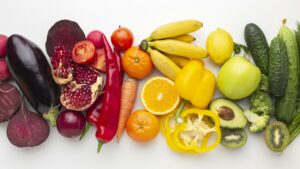Why is it recommended to include fruit and vegetables from the early feeding stages?
Fruit and vegetables are primarily known as sources of minerals and vitamins which are required to support the various chemical reactions taking place in the body, promote normal growth and development, and boost the immune system. Yet, in addition, they are also a very good source of bioactive compounds – chemicals which are known to improve one’s health status. On top of this, these food groups are rich in fibre which is very much needed to promote normal bowel movement and keep digestive system related issues at bay.

How many portions per day?
Many are familiar with the 5 a day statement. Yet a number wrongly give it a sweet tweak by thinking that one should consume 5 fruits daily. The Mediterranean diet recommends 3 fruits and 2 vegetable servings daily.
When it comes to serving size, a person’s hand could be a very good portion indicator including with children. In the case of fruit, one serving is equivalent to what would fit in a scooped hand, whilst for vegetables, a child’s fist size is one serving.

How do I get my child to eat fruit and vegetables?
The earlier in life one starts, the higher the chance that children would accept the taste and texture of these food groups. Yet, as children start growing up, experiencing more food, and becoming more verbal, they can easily start avoiding or refusing what in their decision does not taste as good. Let’s be honest- are vegetables truly that tasty? Most of us likely consume them only based on the knowledge that they are required as part of a balanced diet, rather than because they specifically provide us with a tasteful pleasure. Whilst we as adults have the cognitive skills to consume certain food groups through the understanding of their role in our health, this is not possible especially with young children. Hence, the following are some tips which can encourage children to keep consuming fruit and vegetables:
– Always present fruit and vegetable with every meal, and even as snacks
– If refused, encourage children to still consume at least a bite or two
– Use herbs and spices to give fruit and vegetables more flavour
– Be creative! Some children can get bored with the same tastes and textures. Varying between raw, cooked, steamed, or roasted fruit/veggies could help.
– For the picky children who refuse to consume fruit and/or vegetables in solid form, try including them in puree form in soups, pasta sauces, and in sweet or savoury muffins/loaves.
Whenever possible fruit and vegetables are best provided with the skin and all, as this not only provides additional nutrients and fibre, but also helps to reach satiety more quickly and helps with better regulation of sugar level in the blood.
Whilst it is important to encourage a rainbow of plant-based food from the early years, it is essential to have parents/guardians lead by example, where regular consumption of fruit and vegetables would be a normal practise by all the members in the household.
Share this article on social media
blog | Kids Corner